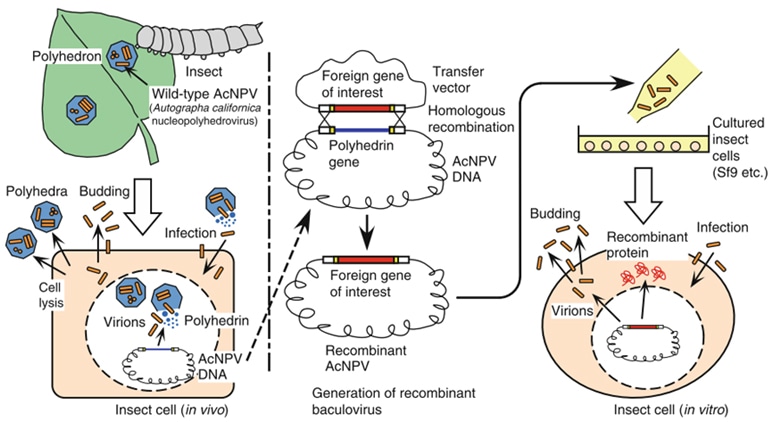Insect Cell Line Construction Service
Insect cells can efficiently express recombinant proteins and are mostly used for the development of virus-like particles and vaccines. It has been proven that insect cells are excellent platforms for the production of recombinant antibodies. Creative Biolabs can provide different insect systems to allow constitutive or inducible production of recombinant proteins.
In recent years, insect cells have been extensively used for the production of different classes of biologically active recombinant proteins. There are two insect expression systems: baculovirus-insect cell system (BEVS) and Drosophila expression system (DES).

Fig.1 Diagram depicting the workflow of baculovirus-insect cell expression platforms for the synthesis of heterogeneous proteins.1
The baculovirus-insect cell system is the most widely used insect cell-based expression system especially for transient expression. Baculovirus is rod-shaped viruses, which have a large, circular double-stranded DNA genome. These viruses exclusively infect arthropods, mainly insects. In baculovirus-insect cell system, the commonly used baculoviruses are in the genus Nucleopolyhedrovirus including AcNPV (Autographa californica nucleopolyhedrovirus) and BmNPV (Bombyx mori nucleopolyhedrovirus). During the infection of Nucleopolyhedrovirus, there are immense quantities of two viral proteins synthesized by infected cells, polyhedron and p10. Polyhedrin molecules assemble into polyhedral. Polyhedron and p10 are not essential for replication of the virus. Moreover, the promoter of these two genes is remarkably strong. Therefore, the polyhedrin or/and p10 gene/genes can be replaced with the gene of interest to construct a recombinant nucleopolyhedrovirus to obtain large quantities of products. In order to improve baculovirus expression vectors, two modifications have been established: transfer plasmid modification and parental baculovirus genome modifications. Various forms of recombinant proteins have been expressed at high yields using baculovirus-insect cell system, including whole antibodies, Fab fragments, scFv fragments and related proteins.
In insect systems, insect larvae, pupae and cell lines can all work as hosts. Sf21, Sf9 and BTI-TN-5B1-4 (High Five) are most commonly used with AcNPV. The three cell lines are derived from lepidopteran insects. Sf21 and Sf9 are derived from the pupal ovarian tissue of Spodoptera frugiperda, a fall army worm. BTI-TN-5B1-4 (High Five) is from the ovarian cells of Trichoplusia ni, cabbage looper. While transformed stable insect cell lines are often from dipteran insects including fruit flies and mosquitoes. Among which, the cell line Drosophila melanogaster Schneider 2 (S2) has been most commonly used. In the system, an antibiotic resistance gene using as a selectable marker is co-transfected with the heterologous gene of interest. Drosophila metallothionein is often used as the promoter for inducible expression. Drosophila actin 5C promoter has been demonstrated for constitutive secretory expression in S2. Furthermore, the mentioned lepidopteran insect cells, Sf9 and High Five can also be used to establish stable cell lines, among which the choice of a promoter is crucial. The combination of AcNPV hr5 enhancer and AcNPV-immediated early promoter IE1, BmNPV IE-1 transactivator, BmNPV HR3 enhancer, and B. mori actin promoter with either a blasticidin or a neomycin resistance gene have been reported in stably transformed High Five. And OpNPV immediate early 2 promoter OpIE2 is used in Sf9.
Based on the recombinant proteins of interest and the special requirements of clients, Creative Biolabs provides insect systems including transient and stable expression systems to get high-quality products at high yields.
Reference:
-
Tang, Yanyang, et al. "Construction of gateway-compatible baculovirus expression vectors for high-throughput protein expression and in vivo microcrystal screening." Scientific reports 10.1 (2020): 13323. Distributed under Open Access license CC BY 4.0, without modification.
To discuss your Insect Cell Line Construction Service demands or to request a proposal, please contact us.
For Research Use Only. Not For Clinical Use.




